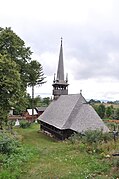Căpușu Mare
Căpușu Mare
Magyarkapus | |
|---|---|
 Wooden church in Agârbiciu | |
 Location in Cluj County | |
| Coordinates: 46°47′20″N 23°17′30″E / 46.78889°N 23.29167°E | |
| Country | Romania |
| County | Cluj |
| Established | 1282 |
| Subdivisions | Agârbiciu, Bălcești, Căpușu Mare, Căpușu Mic, Dângău Mare, Dângău Mic, Dumbrava, Păniceni, Straja |
| Government | |
| • Mayor (2020–2024) | Gheorghe Iancu[1] (PNL) |
| Area | 58.4 km2 (22.5 sq mi) |
| Elevation | 469 m (1,539 ft) |
| Population (2021-12-01)[2] | 3,451 |
| • Density | 59/km2 (150/sq mi) |
| Time zone | EET/EEST (UTC+2/+3) |
| Postal code | 407145 |
| Area code | +(40) x64 |
| Vehicle reg. | CJ |
| Website | www |
Căpușu Mare (Hungarian: Magyarkapus; German: Grossthoren) is a commune in Cluj County, Transylvania, Romania, located 27 km (17 mi) west of the city of Cluj-Napoca. It is composed of nine villages: Agârbiciu (Egerbegy), Bălcești (Balkujtelep), Căpușu Mare, Căpușu Mic (Magyarkiskapus), Dângău Mare (Bánffydongó), Dângău Mic (Gyerőfidongó), Dumbrava (Gyerővásárhely), Păniceni (Gyerőfalva), and Straja (Gesztrágy).
Geography
[edit]The commune is situated in the northern foothills of the Apuseni Mountains, at an altitude of 469 m (1,539 ft), on the banks of the rivers Căpuș and Agârbiciu. It is located in the central-west part of the county, 24 km (15 mi) east of Huedin and 28 km (17 mi) west of the county seat, Cluj-Napoca. Căpușu Mare is crossed by national road DN1, which links Bucharest with the northwestern part of the country and the border with Hungary.
Economy
[edit]The main industry is an iron ore extraction facility. It is a tourist destination, with many new motels built in recent years.
Demographics
[edit]According to the 2011 census, Romanians made up 55.2% of the population, Hungarians made up 37.3%, and Roma made up 5.6%.[3] At the 2021 census, Căpușu Mare had a population of 3,451; of those, 59.95% were Romanians, 30.8% Hungarians, and 6.49% Roma.[4]
References
[edit]- ^ "Results of the 2020 local elections". Central Electoral Bureau. Retrieved 11 June 2021.
- ^ "Populaţia rezidentă după grupa de vârstă, pe județe și municipii, orașe, comune, la 1 decembrie 2021" (XLS). National Institute of Statistics.
- ^ Tab8. Populaţia stabilă după etnie – judeţe, municipii, oraşe, comune, 2011 census results, Institutul Național de Statistică, accessed 17 February 2020.
- ^ "Populația rezidentă după grupa de vârstă, pe județe și municipii, orașe, comune, la 1 decembrie 2021" (in Romanian). INSSE. 31 May 2023.






